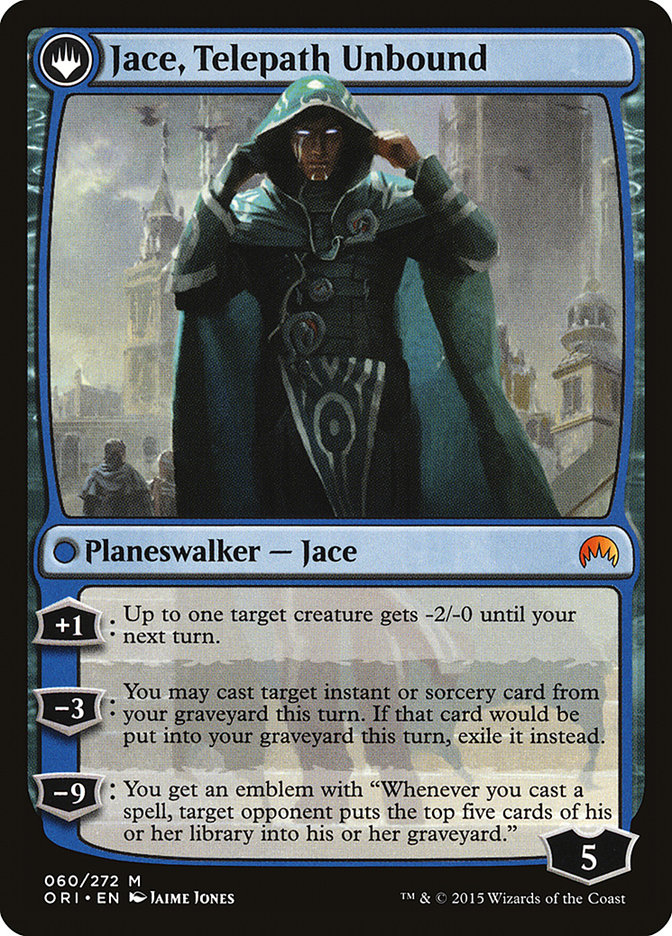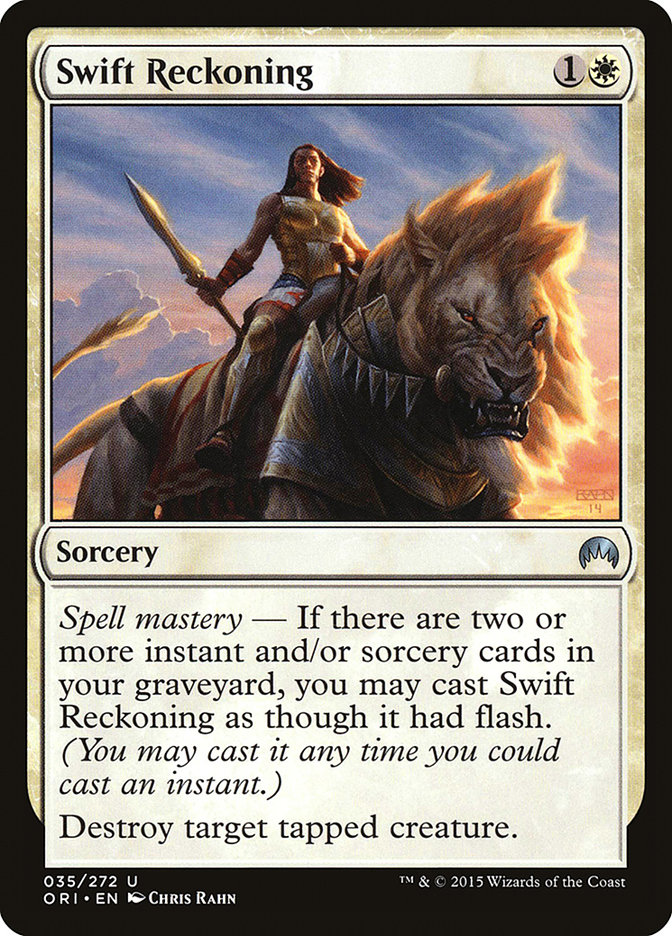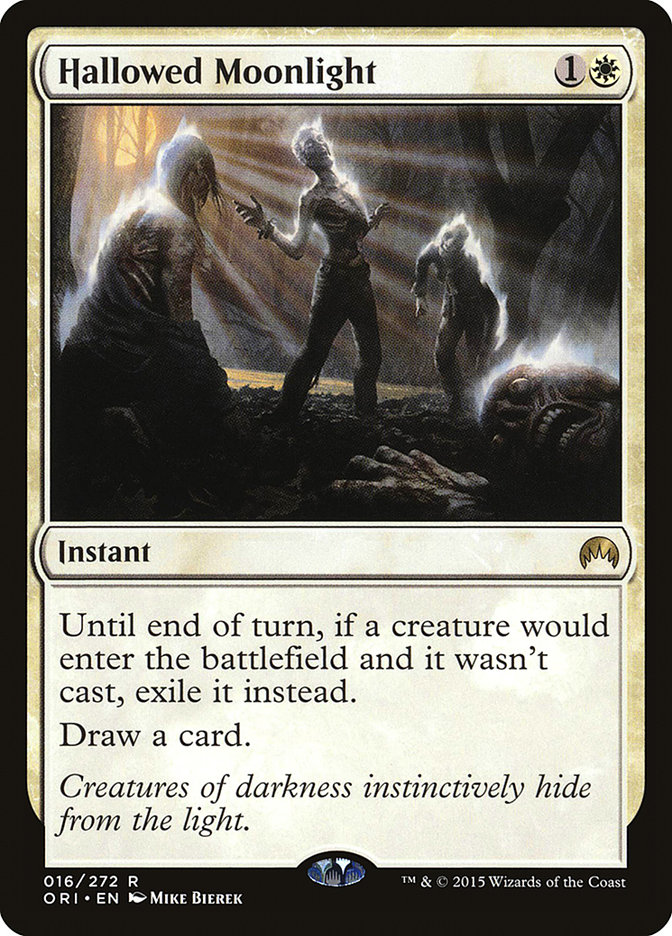Two weeks ago, my answer to the question, “What do you think is the best card in Magic Origins?” would have been Nissa, Vastwood Seer. Don’t get me wrong, the green Borderland-walker is an incredible card. I wouldn’t be surprised if she had the best Week One performance at SCG Chicago, and maybe even continued that streak through the Pro Tour and SCG Regionals. That being said, with every passing day I come to realize that everyone is underrating Jace, Vryn’s Prodigy and that he will ultimately be a dominant force in Standard.
A Worse Merfolk Looter?
Most of what I’ve read regarding popular conceptions towards Jace is that he is considered a Merfolk Looter that has the liability of eventually flipping into a subpar Planeswalker. Before I even address the latter half of that statement, let’s take a look at the classic blue two-drop. Historically, Merfolk Looter has been a powerful tournament-caliber Constructed role-player that is currently deemed too powerful for Limited play. What does including Merfolk Looter in your deck allow you to do?
- Build a more consistent deck. The ability to “loot” repeatedly grants the ability to play more lands on average while mitigating the risk of flooding out. Having access to greater selection means that you will play games of Magic on-curve more frequently.
- Play high-impact cards. You have a broader range of cards you can reasonably include in your deck. It is easier to justify playing a few select cards for specific matchups – they are going to be easier to find, and when they have no bearing on the game they can simply be discarded.
- Abuse a mechanic. In the past, Merfolk Looter has seen the most success utilizing either a “Graveyard Matters” strategy (Dredge/Reanimator) or Madness. Today we are looking at Delve. When your two-drop is able to effectively fuel your advantage engine or undercosted threat, then your deck becomes incredibly efficient. Delve also has the added bonus of removing additional cards from your graveyard if you are in a position where you would rather keep looting every turn rather than igniting Jace’s spark.
Leveraging An Undervalued Asset
So how can we use that “subpar planeswalker?” The best way to exploit the Telepath Unbound is simple: cheap spells. While many have spoken about how they would rather prefer Jace to simply never flip, I strongly disagree. Everything is contextual of course, but when it is possible – and often easy – to transform Jace by the fourth turn, he is a massive threat. Not to your opponent’s life total, but to snowball your position in the game.
The fact of the matter is that you’re only spending two mana on Jace, period, and you are still allowed to play Magic and interact with your opponent past that point. Post-ignition, Jace is incredibly durable and is more than capable of not only protecting himself, but putting your opponent in the “squeeze.” His massive starting loyalty combined with his +1 ability means that by himself, the Telepath Unbound can retain parity at five loyalty against a Deathmist Raptor, for example. To continue to either pressure Jace or its controller’s life total, one must commit a significant amount to the board… which can play right into any Languish or End Hostilities strategy.
One of the more practical examples I’ve encountered is how powerful Jace, Telepath Unbound is at fighting the midrange Jeskai strategy. These types of decks have often taken a “Protect the Queen” stance utilizing cards like Mantis Rider and protecting or backing it up with burn spells. That clock just isn’t effective against a purely-defensive Jace, who can buy his owner all the time they need to set up and play their haymaker spells.
Again, this is a wide range of implications for a two-mana spell and we haven’t even gotten to the best part – his -3 loyalty ability or, the “Snapcaster effect.” As I noted previously, putting a Looter in your deck allows you a much wider range in deckbuilding and grants the ability to play high-impact cards for specific matchups. Well what if your Looter also let you play that card twice? Three times? Jace, Telepath Unbound is an incredibly dangerous card for your opponent to leave around long-term, especially with cards like Dig Through Time and Treasure Cruise floating around.
The beauty of Jace, Vryn’s Prodigy is that ultimately his opportunity cost is quite low. While there is some argument that U/x control decks typically don’t have effective targets for opposing removal, my answer is that you simply need to build your decks differently. The key is his two-mana cost, which nearly guarantees that, except against Bile Blight and burn spells, Jace will be “trading up” and maintaining efficiency. In the case of burn spells, we’re probably even excited as blue mages to finally not have something going directly to our face!
Under the assumption that our new looter friend is in fact a giant lightning rod, how about we start looking at some decklists? One Elder Dragon’s Command has started to pick up popularity at the end of this chapter in Standard, and I can’t imagine a better two-mana creature to pair with it.
Creatures (9)
Planeswalkers (3)
Lands (27)
Spells (21)

Don’t let those Harbinger of the Tides fool you, this is a control deck that is interested in games going long and slowly grinding out an advantage with Jace. Ojutai’s Command is a workhorse in this deck, not only doing a solid Cryptic Command impression and granting us great deal of redundancy on copies of the Prodigy, but also allowing you to take a powerful defensive posture by gaining life and re-buying Harbinger of the Tides. While in the past U/W Control had a big problem with cards like Stormbreath Dragon, Harbinger allows you to fear the mighty Theros Dragon considerably less, and it is also a great early play against super-aggressive decks or a huge tempo swing against midrange and their cast of the “Languish Welcoming Party.”
I’ve also included two new white instants from Magic Origins that I think are going to prove pivotal for cleaning up a lot of the problems U/W Control has had in the past.
Swift Reckoning is sweet and simple. On the draw it can serve a purpose like cleaning up an Elvish Mystic to deny your green opponent an accelerated four-drop, and it is also powerful later in the game as a hard instant-speed removal spell. I expect this card to see a great deal of play.
Hallowed Moonlight is a little more interesting. While it does have the have the surface ability to fight Deathmist Raptor to some degree, I’m more interested in it for two things:
- It is effectively a counterspell against any token producers like Hordeling Outburst, which this deck has some difficulty in dealing with.
- It simply cycles against control decks or whenever you’re in a pinch. Moonlight is far more versatile than it appears on the surface, also fighting interactions like Ashiok’s minus ability and Xenagos the Reveler’s 0.
I stated that the best way to exploit Jace is to overload on cheap spells. While flashing back Dig Through Time and End Hostilities is certainly powerful, how might we take a more innovative approach to deck building to really bury our opponents quickly?
Creatures (16)
Lands (23)
Spells (21)

I hesitate to call this a Heroic deck, especially with this iteration finally chopping Favored Hoplite, but there certainly are a striking number of similarities. Our bevy of cheap protection spells allow our creatures to get into combat easily for favorable trades which will ultimately fuel the core of the deck: Treasure Cruise. We are looking to go wide, really wide, with Monastery Mentor instead of moving all-in on a cheap threat wearing an enchantment. It just so happens that our defensive spells keep our major pieces alive – Mentor and Jace – while also fueling our graveyard and giving excellent targets for the Telepath Unbound before we get in combat. Remember: just because you’ve given a spell flashback doesn’t mean you have to immediately cast it, almost all of the late-game lines in this deck involve giving a protection spell flashback before combat and then letting your opponent choose how to get blown out.
There is still a great deal of design space to explore in this type of deck. I would really like to fit in Harbinger of the Tides similarly to our U/W Control list, but with us wanting to have WW available frequently to cast multiple cheap white instants, I suspect that Harbinger’s UU cost will ultimately be a liability.
Decks going heavy on cards like Languish may ultimately prove to be an issue here, but just as with Heroic, properly pacing our threats is key. Monastery Mentor essentially requires a Languish immediately before he goes completely crazy, and you are able to diversify your board position by flipping Jace or just outpacing sweepers with repeated Treasure Cruises.
Before we conclude, I’d like to apply this deckbuilding principle with Jace to my favorite card in Magic Origins: Demonic Pact!
Creatures (6)
Lands (25)
Spells (29)

I haven’t gotten to try out this iteration, but honestly it looks great to me. Having a ton of cheap spells and disruption means that control decks will have a hard time containing your undercosted threats while you will always have the means to interact with aggressive decks. While there is still some concern with having to play Void Snare, this list’s focus on getting Pacts out quickly and repeatedly will mean that your opponents are always pressed for resources and there’s nothing better for putting them in a quick Languish pinch then a fast Pact backed by the threat of Void Snare re-buying it.
Jace is just doing everything we want in this deck, from giving us longevity with Treasure Cruise and Void Snare re-buys to additional hand disruption that helps make sure your control opponents can’t get off the ground to simply flashing back a removal spell. This is a perfect shell for him, and my initial assumption of fitting Demonic Pact into a strict U/B Control deck was likely completely off the mark.
If there’s some takeaway today, I hope it is this: Jace, Vryn’s Prodigy is neither just a Merfolk Looter nor a Tibalt, the Fiend-Blooded. Not only is he capable of smoothing out your early-game draw or blocking Goblin tokens as an apprentice, the Telepath Unbound is also a powerful tool for blue decks operating both defensively and offensively and deserves your attention as players and deckbuilders.




